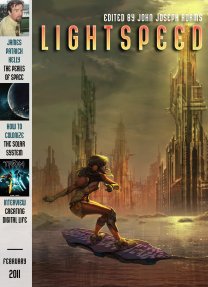 Lightspeed #9, February 2011
Lightspeed #9, February 2011
“Long Enough and Just So Long” by Cat Rambo
“Simulacrum” by Ken Liu
“The Passenger” by Julie Czerneda
“Breakaway, Backdown” by James Patrick Kelly
Reviewed by Bob Blough
Lightspeed is an e-magazine posting two new and two reprint stories per month. Reviewed below are the pair of original pieces. The stories so far have truly been exciting. Out of 16 new stories published last year 10 were either chosen for one (or more) of the Best of the Year anthologies or nominated for the Nebula. That’s a terrific batting average for the first 7 months of this magazine.
This month is another good issue. One story belongs on any year’s best while the other is enjoyable and well worth reading.
Cat Rambo begins her story, “Long Enough and Just So Long” with a reference to Heinlein’s juveniles. The main character is from Mars and named Podkayne, nicknamed Kayne. Kayne has “lower limb reduction syndrome” and uses a mechanical walker when on Luna. Her best friend, Pippi, has high functioning autism. Both encounter a sexbot named Star while relaxing on Luna between their prospecting jobs. They hope to make their fortune by scavenging alien junk built up around a gateway to alien worlds. The sexbot is an AI placed in a physical body that is designed only to give pleasure to its owner. Several of these bots have won their freedom and are now owned by no one.
The story examines the friendship between the two women when Star gets between them, how sex with it affects their friendship and the concept of loyalty. All this intermixes with the SF milieu but somehow fails to hold together as anything but a rather conventional tale of two friends and the man who gets between them. Enjoyable, but light.
“Simulacrum” by Ken Liu is, on the other hand, a much more seriously intentioned story. It uses a great SFnal idea, an “oneiropagida” that takes “a snapshot of the subject’s mental patterns” which becomes “a representation of personality” which can interact to some degree with the viewer. The story revolves around the inventor of the device and his daughter to devastating effect. It excellently intertwines the stories of these two souls in order to discuss memories – real and manufactured, regrets of betrayals committed and reasons misunderstood. It is a story about the destruction of a family caused by the device and its ongoing effects. It explores the pathos in the situation and examines our inability to allow people to change in a very poignant manner. All this is compactly rendered and is wonderful work by Mr. Lui. With stories like this, Lightspeed seems poised to continue its winning streak of publishing high quality science fiction.